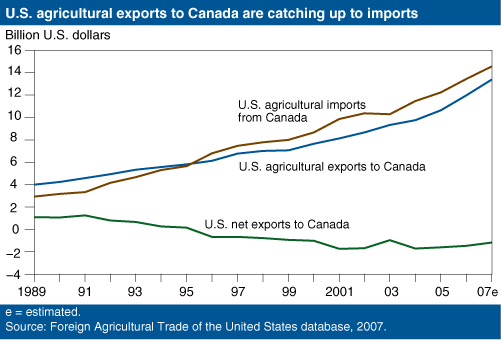Canadian Dollar Reaches Parity With U.S. Dollar
- by Mathew Shane and Paul Sundell
- 2/1/2008
Canadian Dollar Reaches Parity With U.S. Dollar
In September 2007, the Canadian dollar reached parity with the U.S. dollar for the first time since 1976. In reaching this mark, the Canadian dollar had appreciated more than 33 percent against the U.S. dollar since February 2002, when the Canadian dollar reached a low of 1.6 to 1 U.S. dollar. While other major currencies have appreciated at a similar rate against the dollar over the same period, none is more important to U.S. trade than Canada’s.
Canada, which accounts for about 20 percent of total U.S. trade, is the largest destination for U.S. exports and the leading source of U.S. imports of products and services. Canada’s status as top trade partner is due to its long common border with the U.S., similar cultures and tastes in the two countries, and greatly increased trade liberalization resulting from the Canadian Free Trade and the North American Free Trade Agreements.
Canada is also the largest agricultural trading partner for the U.S. Factors boosting Canada’s agricultural trade ranking include slowing growth in food and agricultural demand in Japan and Europe and greater integration of agricultural production between the United States and Canada. For instance, while Canada is the largest destination for U.S. horticultural products, the U.S. is also a major importer of Canadian hothouse tomatoes.
Changes in exchange rates are a powerful mechanism for encouraging and discouraging trade. When a foreign currency appreciates relative to the dollar, U.S. commodities and products become cheaper in the foreign currency—boosting demand for U.S. exports. The partner country’s products become more expensive in the U.S—dampening demand for its imports.
Recent developments in U.S.-Canada trade illustrate this tendency. With the appreciation of the Canadian dollar, U.S. agricultural exports to Canada have been increasing much faster than agricultural imports from Canada. U.S. exports of fruit and nuts, fresh vegetables, and beef increased at an annual rate of 10.7 percent between 2002 and 2007, after an annual growth rate of only 3.5 percent during the previous 5 years.
Total agricultural imports from Canada grew 6.5 percent over this period, down from a previous rate of 7.1 percent. U.S. imports of Canadian meat and bakery products grew particularly slowly. Since adjustments to changing exchange rates take time, this pattern of increasing export growth and declining import growth is likely to become stronger over the next few years.
This article is drawn from:
- Foreign Agricultural Trade of the United States (FATUS). (n.d.). U.S. Department of Agriculture, Economic Research Service.
- Agricultural Exchange Rate Data Set. (n.d.). U.S. Department of Agriculture, Economic Research Service.
You may also like:
- Macroeconomics & Agriculture. (n.d.). U.S. Department of Agriculture, Economic Research Service.
- U.S. Trade Growth: A New Beginning or a Repeat of the Past?. (2007). Economic Research Service. in Amber Waves, Vol. 5, Issue 4.


